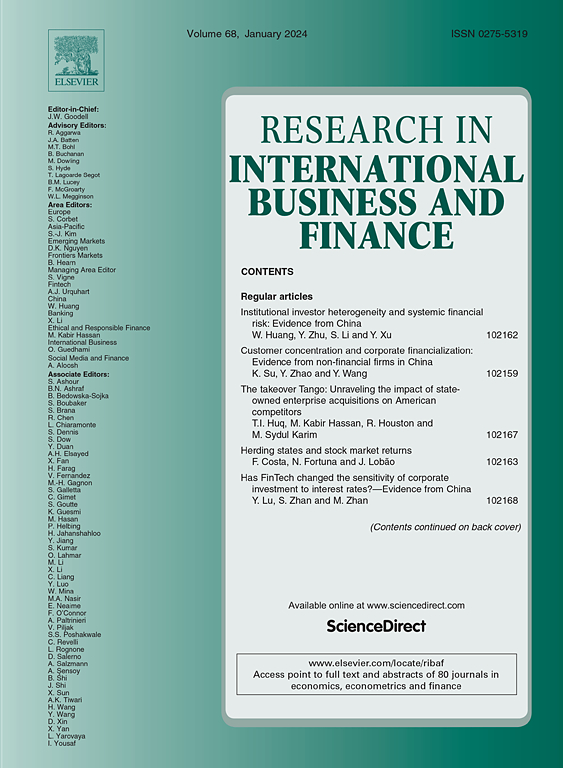P2P网贷是否促进了传统的银行普惠金融?来自34个发展中经济体的空间证据
IF 6.9
2区 经济学
Q1 BUSINESS, FINANCE
Research in International Business and Finance
Pub Date : 2025-05-01
DOI:10.1016/j.ribaf.2025.102947
引用次数: 0
摘要
虽然先前的文献经常表明,P2P借贷解决了借款人的信贷需求,没有得到正规银行部门的服务和服务不足,但本文认为,P2P借贷的意义不仅仅是弥合银行造成的信贷缺口。通过赋予借款人(通常是被边缘化的实体)知识、技能、信心和必要的文件,P2P借贷发挥了变革性的作用,促进了这些借款人最终被接受并融入传统银行体系。然后,考虑到这些国家之间的空间依赖性,我们正式调查了2013-2020年间34个发展中国家P2P借贷对传统银行金融普惠的影响。研究发现,首先,传统普惠金融存在正的跨国空间依赖关系,为空间分析的应用提供了依据。其次,利用最合适的空间德宾模型,我们发现P2P借贷增强了传统的普惠金融,无论是在国内还是在邻近经济体。第三,在排除发展中国家(即中国)中最大的P2P贷款机构和/或新冠疫情(即2020年)的影响后,上述结论成立。第四,消除新冠肺炎效应加强了P2P借贷对传统普惠金融的积极影响,表明经济稳定和互联互通对促进这一关系的重要性。最后,这些发现的稳健性与替代权重矩阵确认。本文章由计算机程序翻译,如有差异,请以英文原文为准。
Does P2P lending promote the traditional bank-based financial inclusion? Spatial evidence from 34 developing economies
Whilst prior literature often suggests that P2P lending address the credit needs of borrowers unserved and underserved by the formal banking sector, this paper contends that the significance of P2P lending extends beyond merely bridging the credit gap created by banks. By empowering the borrowers (often marginalised entities) with knowledge, skills, confidence and necessary documentations, P2P lending plays a transformative role, facilitating these borrowers towards their eventual acceptance and integration into the traditional banking system. We then formally investigate the impact of P2P lending on the traditional bank-based financial inclusion for a group of 34 developing countries during 2013–2020, considering spatial dependence amongst these nations. We find that, first, there is positive cross-country spatial dependence in the traditional financial inclusion, substantiating the use of spatial analysis. Second, utilising the Spatial Durbin Model which is found to be the most suitable specification, we find that P2P lending enhances the traditional financial inclusion, both domestically and in neighbouring economies. Third, the above holds when the largest P2P lender amongst developing nations (i.e., China) and/or the impact of the Covid pandemic (i.e., year 2020) is excluded. Fourth, removing the Covid-19 effect strengthens the positive influence of P2P lending on traditional financial inclusion, signifying the importance of economic stability and connectivity in fostering this relationship. Finally, the robustness of these findings is confirmed with an alternative weight matrix.
求助全文
通过发布文献求助,成功后即可免费获取论文全文。
去求助
来源期刊

Research in International Business and Finance
BUSINESS, FINANCE-
CiteScore
11.20
自引率
9.20%
发文量
240
期刊介绍:
Research in International Business and Finance (RIBAF) seeks to consolidate its position as a premier scholarly vehicle of academic finance. The Journal publishes high quality, insightful, well-written papers that explore current and new issues in international finance. Papers that foster dialogue, innovation, and intellectual risk-taking in financial studies; as well as shed light on the interaction between finance and broader societal concerns are particularly appreciated. The Journal welcomes submissions that seek to expand the boundaries of academic finance and otherwise challenge the discipline. Papers studying finance using a variety of methodologies; as well as interdisciplinary studies will be considered for publication. Papers that examine topical issues using extensive international data sets are welcome. Single-country studies can also be considered for publication provided that they develop novel methodological and theoretical approaches or fall within the Journal''s priority themes. It is especially important that single-country studies communicate to the reader why the particular chosen country is especially relevant to the issue being investigated. [...] The scope of topics that are most interesting to RIBAF readers include the following: -Financial markets and institutions -Financial practices and sustainability -The impact of national culture on finance -The impact of formal and informal institutions on finance -Privatizations, public financing, and nonprofit issues in finance -Interdisciplinary financial studies -Finance and international development -International financial crises and regulation -Financialization studies -International financial integration and architecture -Behavioral aspects in finance -Consumer finance -Methodologies and conceptualization issues related to finance
 求助内容:
求助内容: 应助结果提醒方式:
应助结果提醒方式:


